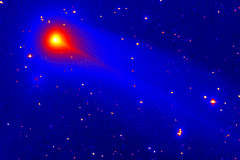 |
 |
An ideal way to introduce students to comets is to provide them with a "hands-on" astronomical experience.
Dr. Robert Chapman and Dr. Lynn Bondurant describe the composition of a comet in their publication Comet Halley Returns (listed under Resources) as follows: "In the early 1950's, Dr. F. L. Whipple of the Harvard College Observatory presented a picture of comets that, with some minor modifications, is accepted today. Whipple proposed that the nucleus of a comet is in effect a dirty iceberg, a large mass of frozen water, methane, ammonia, carbon dioxide, and other constituents, in which is embedded meteor-like solid particles of various sizes."
The "Making a Comet in the Classroom" recipe produces a model of this unusually cratered object that definitely looks like it came from outer space. Be sure to take safety precautions when holding the comet -- this is really a "gloves-on" rather than a "hands-on" activity.
Barbara Sprungman, a credentialed teacher and space science education writer, is an associate of Space Data Resources & Information in Washington, D.C.
Did Comets Kill the Dinosaurs? is a Dell Yearling Nonfiction book from Isaac Asimov's Library of the Universe series published in 1988 that sells for $4.95.
For students 9-14 years old, The Return of the Comet by Dennis Schatz is a teacher/parent guide that sells for $5 including shipping and handling from the Pacific Science Center Gift Shop, 200 2nd Avenue North, Seattle, WA 98109, or call (206) 443-2870.
The Comet Book by Robert D. Chapman and John C. Brandt is a popular book for older elementary students through adults that was published by Jones and Bartlett Publishers of Boston in 1984.
Comet Halley Returns: A Teachers' Guide, by Dr. R. Lynn Bondurant, Jr. and Dr. Robert D. Chapman, was published for the return of Halley's Comet in 1985-86, but contains a wealth of information on important concepts about comets, including their historical significance, as well as a number of activities for the classroom. Public libraries and NASA Teacher Resources Centers will likely have copies that can be duplicated of this NASA publication.
Copyright 1985 by Dennis Schatz A dramatic and effective way to begin a unit on comets is to make your own comet right in front of the class. The ingredients for a comet are not difficult to find and watching a comet being "constructed" is something the students will remember for a long time.
The "ingredients" for a six-inch comet are:
Here are the steps for making a 6-inch comet (students make good baker's assistants for this exercise!):
The comet is reasonably safe to touch without getting burned by the dry ice, but it is still best to have a spoon or a stick for the students to use while examining it. As the comet begins to melt, the class may notice small jets of gas coming from it. These are locations where the gaseous carbon dioxide is escaping through small holes in the still-frozen water. This type of activity is also detected on real comets, where the jets can sometimes expel sufficient quantities of gas to make small changes in the orbit of the comet.
After several hours, the comet will become a crater-filled ice ball as the more volatile carbon dioxide sublimates before the water ice melts. Real comets are also depleted by sublimation each time they come near the Sun. Ultimately, old comets may break into several pieces or even completely disintegrate. In some cases, the comet may have a solid, rocky core that is then left to travel around the comet's orbit as a dark barren asteroid.